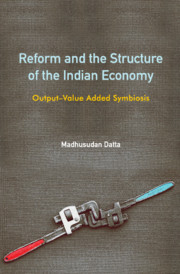Book contents
- Frontmatter
- Dedication
- Contents
- Tables
- Figures and Box
- Preface
- 1 Introduction: The Take-off
- 2 Growth and Structural Change since 1978–79: Issues in Measurement
- 3 Sectoral Shares in Indian GDP: How to Regard It?
- 4 Sectoral Growth: GVA–Output Dichotomy
- 5 Manufacturing Sector in the Indian Economy: Paradox of Growth and Stagnation
- 6 Growth and Sectoral GVA Adjustments
- 7 Demand for Intermediate Services
- 8 Linkages and Key Sectors in the Indian Economy
- 9 Conclusion: A Perspective of Indian Economic Growth
- References
- Index
3 - Sectoral Shares in Indian GDP: How to Regard It?
Published online by Cambridge University Press: 17 March 2020
- Frontmatter
- Dedication
- Contents
- Tables
- Figures and Box
- Preface
- 1 Introduction: The Take-off
- 2 Growth and Structural Change since 1978–79: Issues in Measurement
- 3 Sectoral Shares in Indian GDP: How to Regard It?
- 4 Sectoral Growth: GVA–Output Dichotomy
- 5 Manufacturing Sector in the Indian Economy: Paradox of Growth and Stagnation
- 6 Growth and Sectoral GVA Adjustments
- 7 Demand for Intermediate Services
- 8 Linkages and Key Sectors in the Indian Economy
- 9 Conclusion: A Perspective of Indian Economic Growth
- References
- Index
Summary
‘What would life be without arithmetic, but a scene of horrors?’ To Miss… , 22 July, 1835
—Rev. Sydney Smith, Holland (1855)Introduction
The manufacturing sector of the Indian economy has been widely held to be an underperformer, defying the traditional idea contained in stylized facts summarized by Kuznets (1971) and Chenery and Taylor (1968) (henceforth, K-CT) regarding the evolving pattern of sectoral shares in GDP in the development process of an economy. The World Bank (2004) has described India's recent experience as a services revolution. In more informal discussions, this development is often viewed with some degree of reservation – the feeling is that services are fleeting while material goods last; therefore, growth with a declining share of the secondary sector in GDP is not considered as solid growth. Even if one does not subscribe to this idea (we have discussed the point in detail in the next chapter), it still remains an interesting question from the point of view of structural changes. In this context we discuss the question: what really is the share of manufacturing or industry in Indian GDP and how should we regard it?
The K-CT line of thinking would suggest that the trend of industry's share in India should have been rising and placed at a higher level than what it is now. Comparison with China makes the point particularly stark and this point has appeared time and again in the literature (Bosworth and Collins, 2007; Kochhar et al., 2006). We raise some pertinent questions here regarding data and methodology in use, because underestimation in one case and overestimation in the other would make comparison very hazardous. Then, keeping these points in view, we proceed to evaluate India's standing with regard to levels and trends of relative shares of industry, manufacturing and services in the context of recent development experience of countries above a minimum size.
In the following section we take a hard look at the Chinese data on sectoral shares in view of wide misconceptions that prevail and take a quick look at the Indian data with respect to its nature and appropriateness for comparison with other nations.
- Type
- Chapter
- Information
- Reform and the Structure of the Indian EconomyOutput-Value Added Symbiosis, pp. 35 - 52Publisher: Cambridge University PressPrint publication year: 2020



